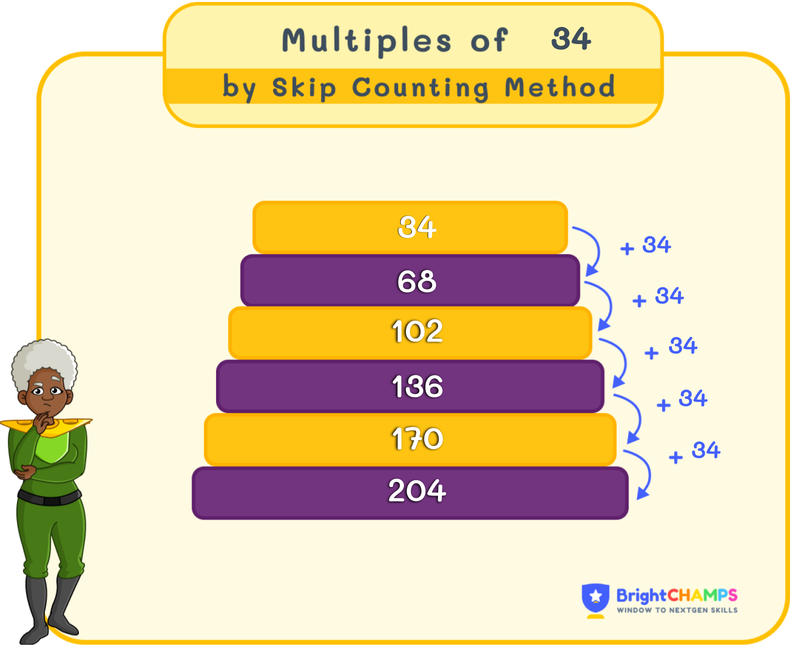
 150 Learners
150 LearnersLast updated on May 26th, 2025

Multiples of 34

In math, multiples are the products we get while multiplying a number with other numbers. Multiples play a key role in construction and design, counting groups of items, sharing resources equally, and managing time effectively. In this topic, we will learn the essential concepts of multiples of 34.
What are the Multiples of 34?
Now, let us learn more about multiples of 34. Multiples of 34 are the numbers you get when you multiply 34 by any whole number, along with zero. Each number has an infinite number of multiples, including a multiple of itself. In multiplication, a multiple of 34 can be denoted as 34 × n, where ‘n’ represents any whole number (0, 1, 2, 3,…). So, we can summarize that:
Multiple of a number = Number × Any whole number
For example, multiplying 34 × 1 will give us 34 as the product. Multiples of 34 will be larger or equal to 34.
List of First 20 Multiples of 34
Multiples of 34 include the products of 34 and an integer. Multiples of 34 are divisible by 34 evenly. The first few multiples of 34 are given below:
| TABLE OF 34 (1-10) | |
|---|---|
|
34 x 1 = 34 |
34 x 6 = 204 |
|
34 x 2 = 68 |
34 x 7 = 238 |
|
34 x 3 = 102 |
34 x 8 = 272 |
|
34 x 4 = 136 |
34 x 9 = 306 |
|
34 x 5 = 170 |
34 x 10 = 340 |
| TABLE OF 34 (11-20) | |
|---|---|
|
34 x 11 = 374 |
34 x 16 = 544 |
|
34 x 12 = 408 |
34 x 17 = 578 |
|
34 x 13 = 442 |
34 x 18 = 612 |
|
34 x 14 = 476 |
34 x 19 = 646 |
|
34 x 15 = 510 |
34 x 20 = 680 |
Now, we know the first few multiples of 34. They are 0, 34, 68, 102, 136, 170, 204, 238, 272, 306, 340,...
Operations with Multiples of 34
Understanding the multiples of 34 helps solve mathematical problems and boost our multiplication and division skills. When working with multiples of 34, we need to apply it to different mathematical operations such as addition, subtraction, multiplication, and division.
Sum of First 5 Multiples of 34:
34, 68, 102, 136, and 170 are the first five multiples of 34. When multiplying 34 from 1 to 5, we get these numbers as the products.
So, the sum of these multiples is:
34 + 68 + 102 + 136 + 170 = 510
When we add the first 5 multiples of 34, the answer will be 510.
Subtraction of First 5 Multiples of 34:
While we do subtraction, it improves our comprehension of how the value decreases when each multiple is subtracted from the previous one. 34, 68, 102, 136, and 170 are the first five multiples of 34. So, let us calculate it as given below:
34 - 68 = -34
-34 - 102 = -136
-136 - 136 = -272
-272 - 170 = -442
Hence, the result of subtracting the first 5 multiples of 34 is -442.
Average of First 5 Multiples of 34:
To calculate the average, we need to identify the sum of the first 5 multiples of 34, and then divide it by the count, i.e., 5. Because there are 5 multiples presented in the calculation. Averaging helps us to understand the concepts of central tendencies and other values. We know the sum of the first 5 multiples of 34 is 510.
34 + 68 + 102 + 136 + 170 = 510
Next, divide the sum by 5:
510 ÷ 5 = 102
102 is the average of the first 5 multiples of 34.
Product of First 5 Multiples of 34:
The product of given numbers is the result of multiplying all of them together. Here, the first 5 multiples of 34 include: 34, 68, 102, 136, and 170. Now, the product of these numbers is:
34 × 68 × 102 × 136 × 170 = 13,618,176,000
The product of the first 5 multiples of 34 is 13,618,176,000.
Division of First 5 Multiples of 34:
While we perform division, we get to know how many times 34 can fit into each of the given multiples. 34, 68, 102, 136, and 170 are the first 5 multiples of 34.
34 ÷ 34 = 1
68 ÷ 34 = 2
102 ÷ 34 = 3
136 ÷ 34 = 4
170 ÷ 34 = 5
The results of dividing the first 5 multiples of 34 are: 1, 2, 3, 4, and 5.

Common Mistakes and How to Avoid Them in Multiples of 34
While working with multiples of 34, we make common mistakes. Identifying these errors and understanding how to avoid them can be helpful. Below are some frequent mistakes and tips to avoid them:

Multiples of 34 Examples

Problem 1
Kiran is organizing a charity event where she plans to donate toys to children. Each box contains 34 toys. If she donates toys in boxes for 3 consecutive months, how many toys will she have donated after 3 months?

102 toys
Explanation
Each month, Kiran donates 34 toys. To find the total number of toys donated after 3 months, we multiply the number of toys per box by the number of months:
Toys donated each month = 34
Number of months = 3
34 × 3 = 102
Kiran will have donated 102 toys after 3 months.

Problem 2
A new garden has been divided into three sections. In the first section, there are 34 tulips planted. The second section has 68 tulips, and the third section has 102 tulips. How many tulips are there in total in the garden?

204 tulips
Explanation
The garden sections have tulips planted in multiples of 34:
First section: 34 tulips
Second section: 68 tulips
Third section: 102 tulips
34 + 68 + 102 = 204
Therefore, there are 204 tulips in total in the garden.

Problem 3
A tailor is sewing costumes for a theater play. Each costume requires 34 meters of fabric. If the tailor is making costumes for 4 main characters, how much fabric will be used in total?

136 meters
Explanation
To find the total fabric needed, we multiply the amount of fabric needed per costume by the number of costumes:
Fabric per costume = 34 meters
Number of costumes = 4
34 × 4 = 136
The tailor will use 136 meters of fabric in total.

Problem 4
In a library, the first shelf has 34 magazines. The second shelf has twice as many magazines as the first shelf. How many magazines are there on both shelves?

102 magazines
Explanation
The first shelf has 34 magazines. The second shelf has 68 magazines (which is 34 × 2). So the total number of magazines is:
First shelf: 34 magazines
Second shelf: 68 magazines
34 + 68 = 102
Therefore, there are 102 magazines in total on both shelves.

Problem 5
A farmer is packing apples into crates. Each crate holds 34 apples. If he packs apples into crates for 5 days and fills one crate each day, how many apples are packed in total?

170 apples
Explanation
To find the total number of apples packed, we multiply the number of apples per crate by the number of days:
Apples per crate = 34
Number of days = 5
34 × 5 = 170
The farmer will pack 170 apples in total.


FAQs on Multiples of 34
1.How do you find the multiples of 34?
2.What is the LCM of 7 and 34?
3.What are the real-life applications of Multiples of 34?
4.Are multiples of 34 finite or infinite?
5.Is there any odd multiple of 34?
6.How can poems help children in Qatar memorize the Multiplication Table and Multiples of 34?
7.Can learning the Multiplication Table influence creativity in solving Multiples of 34 challenges for kids in Qatar?
8.How do language and cultural differences in Qatar affect the way children learn the Multiplication Table and Multiples of 34?
9.What role does brain development play in mastering the Multiplication Table and Multiples of 34 among early learners in Qatar?
Important Glossaries for Multiples of 34
- Multiple: A multiple represents the product of a number that may be multiplied by an integer. For example, multiples of 34 include 34, 68, 102, 136, etc.
- Number pattern: This refers to how numbers are listed. It should follow a certain sequence. Multiples of 34 are the numbers that consist of the number pattern of 34.
- Even number: An even number refers to any number that can be divided by 2 without leaving any remainder. The last digits of even numbers are 0, 2, 4, 6, or 8. All multiples of 34 are even numbers.
- Divisor: It refers to any number by which another number can be divided without leaving any remainder. 1, 2, 17, and 34 are the divisors of 34.
- LCM (Least Common Multiple): The smallest common multiple shared by two or more numbers. For example, the LCM of 7 and 34 is 238.
Explore More multiplication-tables
About BrightChamps in Qatar


Seyed Ali Fathima S
About the Author
Seyed Ali Fathima S a math expert with nearly 5 years of experience as a math teacher. From an engineer to a math teacher, shows her passion for math and teaching. She is a calculator queen, who loves tables and she turns tables to puzzles and songs.
Fun Fact
: She has songs for each table which helps her to remember the tables




